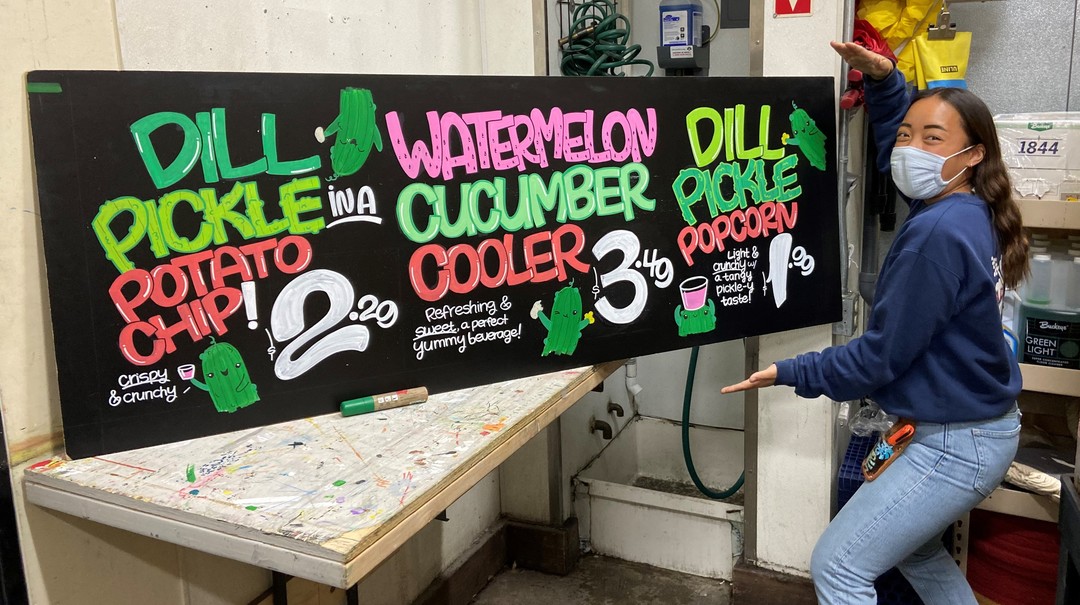Trader Joe’s is beloved for their cozy neighborhood feel, fair prices fit for a college budget, and – of course – delicious products such as Everything but the Bagel Seasoning and multi-flavored Joe-Joe’s cookies. An often overlooked feat of the grocery chain, though, is the art that decorates the store: including hand-painted murals, displays, and signs to promote the store’s products.
23-year-old Sara Nguyen, a senior at Loyola Marymount University studying Fine Arts and Illustration, is one of the crew members responsible for the artistic designs at a Trader Joe’s in Southern California. After graduating high school in 2018, the then-19-year-old applied to TJ’s at the recommendation of her friend, a crew member who knew about Sara’s artistic talents and thought she would be a good fit for the store’s team of in-house artists.

How to become a sign artist at Trader Joe’s
Though she didn’t know much about TJ’s aside from her older sister’s obsession with Cookie Butter Ice Cream and Mandarin Orange Chicken, Nguyen loved the idea and decided to apply.
Nguyen was invited to interview and brought her art portfolio to the first meeting – even though the team didn’t need it, apparently. “Although I applied as a sign artist, [new hires] don’t start with art,” Nguyen recalled. Instead, new hires enter as a crew member. “You needed to know how to work the floor and handle the register first.”
A few days later, Nguyen got the call that she was hired on as a crew member and she quickly donned her first set of hibiscus print. Even though she was out on the floor, Nguyen credits the sign artist who was working there at the time, Ronnie, for always making an effort to get the teenaged artist in the sign room to learn the ropes. Under Ronnie’s guidance, Nguyen practiced writing prices and value signs, and learned how to draw clean and readable numbers and letters in the iconic TJ’s font that’s visible on every shelf sign and display board.

How the signs at Trader Joe’s are created
It may only grab your attention for a second, but quite a bit of thought and planning goes into the standard price tags you’ve seen on the shelf of your local TJ’s – especially since each is handwritten. According to Nguyen, there are specific templates for the “regular” shelf signs (think grocery store staples, such as milk, eggs, and bread), each designed based on category, such as meat or dairy. Once a new product arrives, the artist categorizes it, grabs the correct template, and begins designing. Given that the design is open to an artists’ interpretation beyond the basic product facts, shelf signs may vary a bit from store to store.
There are a few key elements that make a good shelf sign, according to Nguyen: the name of the product, a bullet point that describes and effectively promotes the product, and its weight. Once those elements are sketched out and inked (often with Sharpie), the Crew Member designing the sign will run it through the laminator before adding the price.
How the big signs at Trader Joe’s are designed
The big display boards – you know, the ones that immediately direct your eye to a seasonal tower of taco shells or s’mores ingredients – are a bit different from the standard shelf signs.

“Usually my managers pick popular products or products that need to be sold to put up for display,” Nguyen said, who also loves sharing her own ideas. Design ideas typically come naturally for her, especially when it comes to relating an illustration to a product, but she values the opinions and feedback of friends and peers as well.
Once all of the products are selected for display, the team then consults each products’ “information sheet” with its price, product title, and weight, as well as some descriptions and general information about the product. Nguyen says these fact sheets from Headquarters are really helpful when brainstorming phrases or artwork for display – especially when the product is new, and employees haven’t had a chance to try it yet.
To start the process, Nguyen and other artists measure the correct size board for display and clearly label the margins to ensure none of their careful drawing gets cut off. Next comes the sketch of the key information detailed in the info sheets. Nguyen uses a white POSCA paint marker for the initial sketch of the board. “I usually like filling out and outlining my words and prices with white because once I’m done with that, I layer it over with colors that are kind of cohesive to the product, and it makes it stand out so much more,” she said.
After the font and coloring comes the fun part: the illustrations and doodles, like the cute fruit that Nguyen added to the display board for yogurt-covered pretzels and lemonade. All in all, the display boards take about two hours to create.
The 23-year-old is grateful that she enjoys working for Joe. “If you’re not happy or enjoying what you do or who you’re working with or who you’re working for, don’t pay any mind to it. It’s just going to drain you and your energy,” she advised. “Focus on what’s most important to you and never stop being who you are for anybody.”
It’s safe to say my next TJ’s run will include an extra fifteen minutes staring at the signs and murals – and a few raspberry mousse cakes (Sara’s fave) in my cart.



